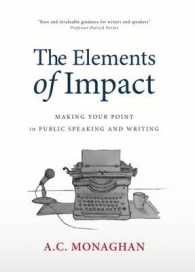Full Description
Understanding change over time is a critical component of social science. However, data measured over time - time series - requires their own set of statistical and inferential tools. In this book, Suzanna Linn, Matthew Lebo, and Clayton Webb explain the most commonly used time series models and demonstrate their applications using examples. The guide outlines the steps taken to identify a series, make determinations about exogeneity/endogeneity, and make appropriate modelling decisions and inferences. Detailing challenges and explanations of key techniques not covered in most time series textbooks, the authors show how navigating between data and models, deliberately and transparently, allows researchers to clearly explain their statistical analyses to a broad audience.
Contents
1. Introduction; Part I. Preliminary Questions: 2. Univariate time series models; 3. Testing for unit roots and stationarity; 4. The exogeneity question; Part II. Single-Equation Regression Models: 5. Regression models for stationary time series; 6. Regression models for unit root time series; 7. Regression models for time series with uncertain properties; Part III. Multiple-Equation Regression Models: 8. Vector autoregression for stationary time series; 9. Vector autoregression for unit root time series; 10. Time series analysis with transparency.






